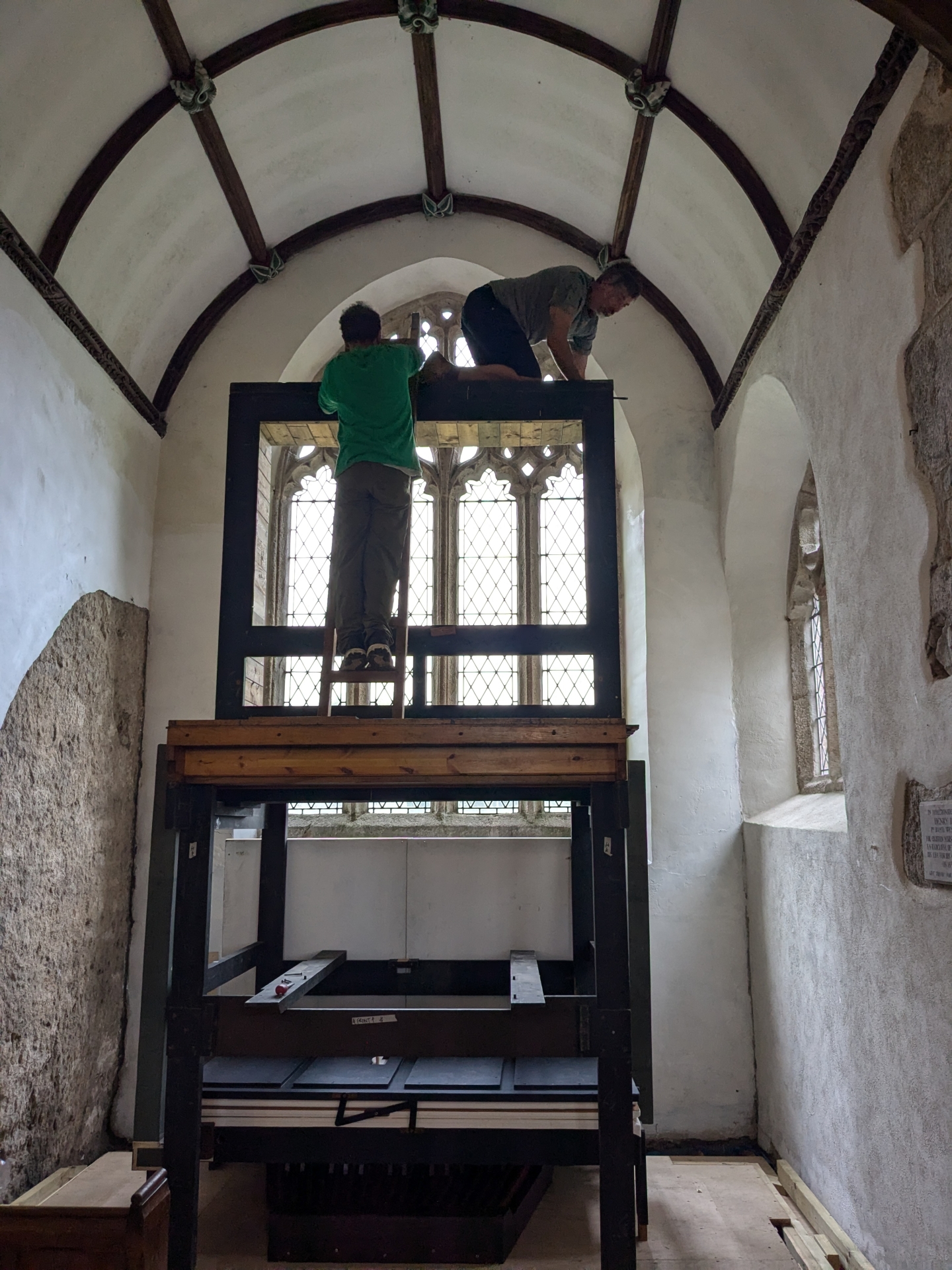
Organ builder Martin Renshaw (in green) and PCC Secretary Peter Blood assemble the countless pieces of the old instrument
When was it made? Where did it go? A century in the life of this Nelson Organ
The newly installed pipe organ at Widecombe Church (affectionately named Horatio) now has a bright future compared to many of its less fortunate contemporaries. Sadly, every week an estimated four pipe organs are sent to landfill. Horatio was built in 1918 by Henry Nelson a small organ builder in Durham. ‘Nelson and Company’ flourished throughout the late Victorian and Edwardian eras, finally closing its doors in 1967.
Horatio’s first home was a Wesleyan Church in Billy Row, a mining village in County Durham. Here it remained until the church closed in 2002.
From there, Horatio went to the home of a local organist before being acquired in 2019 by Martin Renshaw, founder of the charity ‘Pipe Up for Pipe Organs’. Martin believes that organ-making should be placed on the national at-risk crafts register. He says: “Organs are amazing pieces of craftsmanship, memorials to a once-thriving culture of community music-making. At its peak, the British organ-building industry exported instruments all over the world and employed around twelve thousand highly-skilled workers. But now the number of people who know how to design and make an organ has reduced to a tiny handful.”
Meanwhile, Christ Church Cathedral in Oxford was due to embark on a programme of repairs and archaeological investigations in the nave. This necessitated relocating the choir to the chancel. An alternative organ to the huge Rieger organ was needed to accompany the choir and Horatio came to rescue. The original plan was for a six month loan, which subsequently expanded into five years. Unexpectedly, the chancel proved to be a better location for the choir, so in 2024, Christ Church decided to remove the Nelson organ and install a purpose built instrument. But what was to become of Horatio?
Martin Renshaw was aware that Widecombe Church was looking to replace its organ, so he invited the fundraising team up to Oxford to meet Horatio. It was love at first sight. The venerable old 1918 organ was duly purchased and transported to Widecombe, where it rested in a local barn for four months awaiting Diocesan approval. After being given the go-ahead, the old organ was removed. Disaster! Multiple horrors were revealed: rotten floorboards and joists, decaying cement plaster, and copious 1930’s iron central heating pipes.
Once the structural problems were resolved, the installation of Horatio went smoothly. Martin rebuilt the organ over a period of two weeks along with a team of twelve parishioners who cheerfully dived in to help carry, unwrap, paint, screw, oil, clean and polish where needed.
On August 26th 2024, Horatio was scheduled for a grand reveal, fittingly enough a ‘Songs of Praise’ service with nine big hymns. At 9.00am on the morning of the service, Martin was still making adjustments. He sawed two inches off the organ bench during breakfast and arrived back at the church with just fifteen minutes to spare! The result was a triumph: Horatio sounded wonderful and quite a few tears were shed.

Money for the project was raised through concerts, private donations, and a grant from The Benefact Trust, a charity which provides grants for the repair and restoration of church buildings, as well as supporting projects which have a positive impact on communities.
Subscribe or register today to discover more from DonegalLive.ie
Buy the e-paper of the Donegal Democrat, Donegal People's Press, Donegal Post and Inish Times here for instant access to Donegal's premier news titles.
Keep up with the latest news from Donegal with our daily newsletter featuring the most important stories of the day delivered to your inbox every evening at 5pm.